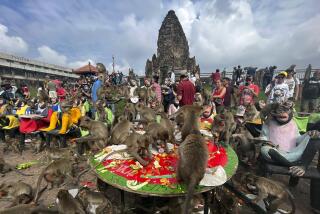Felines Live Life to the Nines
- Share via
BANGKOK, Thailand — The Asian economic crisis has taken its toll on Thailand, but it hasn’t dented the grand lifestyle of one royal family that lives in splendor and lazes about most of the day.
Such decadence at a time of national crisis would probably cause a public outcry if it weren’t for one mitigating factor: The 50 members of the family are Siamese cats whose ancestors lived at the palace of Thailand’s late, beloved king, Rama V.
At their home--which is actually the home of film producer Namdee Witta, 65--the pure white cats live in teak-paneled rooms, drink bottled spring water from gold- and silver-plated bowls and wear collars embedded with cut glass that resembles diamonds.
“They are princes and princesses, and they deserve the best,” Namdee said. “Their value is beyond price. How valuable? Well, I can tell you, six years ago a monk had a Siamese of this breed and he sold it for 150 million baht [about $4 million] to a very wealthy jeweler. The monk built a temple with the money.”
Not surprisingly, Namdee keeps a security guard on duty around the clock at the antique-filled stilted home he and his daughter share with their feline friends. Foreign visitors stop by almost daily to inquire if he’ll sell one. Thais know better than to ask.
His Siamese are a variety known as khao manee, or popularly as “diamond eyes.” Each has eyes of two different colors--emerald green and topaz yellow, or blue and diamond-white--and the breed is unique to Thailand, he said. He believes that his are the last of the purebred khao manee left in Thailand.
How Namdee became the national caretaker of this pampered lot is a brief but interesting story.
King Rama V--the grandfather of Thailand’s current monarch, Bhumibol Adulyadej--was a great cat lover who particularly favored the nine khao manee that he permitted to live in his palace. To make sure bloodlines remained pure and the breed would not become extinct, he assigned the cats’ care and breeding to his son.
The son eventually passed caretaker duties to his daughter, Roengchit Abhakara, who was Namdee’s aunt. It turned out she didn’t care much for cats because they clawed her sofas. So she told her nephew, “Namdee, the king’s request passes to you.”
That was 40 years ago.
Namdee much preferred dogs to cats in those days, but he took his duties seriously. He knew that Thais treasured any link to King Rama V--the khao manee are featured on Thai postage stamps and lottery tickets--and that Thais, unlike some of their Asian neighbors, would never consider frying up a cat for dinner.
“Do I think what I’m doing is unusual? Not at all,” Namdee said. “This is the wish of the king. That’s what my aunt told me. I want our children to know that Thailand has in these cats a treasure of the nation and the world. They are a royal legacy.”
Namdee spends so much of his time looking after the cats--and about $1,000 a month of his personal savings--that he gave up making films seven years ago.
He opened his “living feline museum” to the public last year and has put his younger brother in charge of breeding at a clinic outside Bangkok.
His daughter, Rasamee, rises at dawn to cook the meals the cats receive three times a day--fried mackerel and boiled chicken fillets, along with commercial dry cat food.
“We are doing something for the next generation,” he said. “Maybe by the time they grow up, the elephants will be gone. But the khao manee Siamese will still be here.”
More to Read
Sign up for The Wild
We’ll help you find the best places to hike, bike and run, as well as the perfect silent spots for meditation and yoga.
You may occasionally receive promotional content from the Los Angeles Times.





